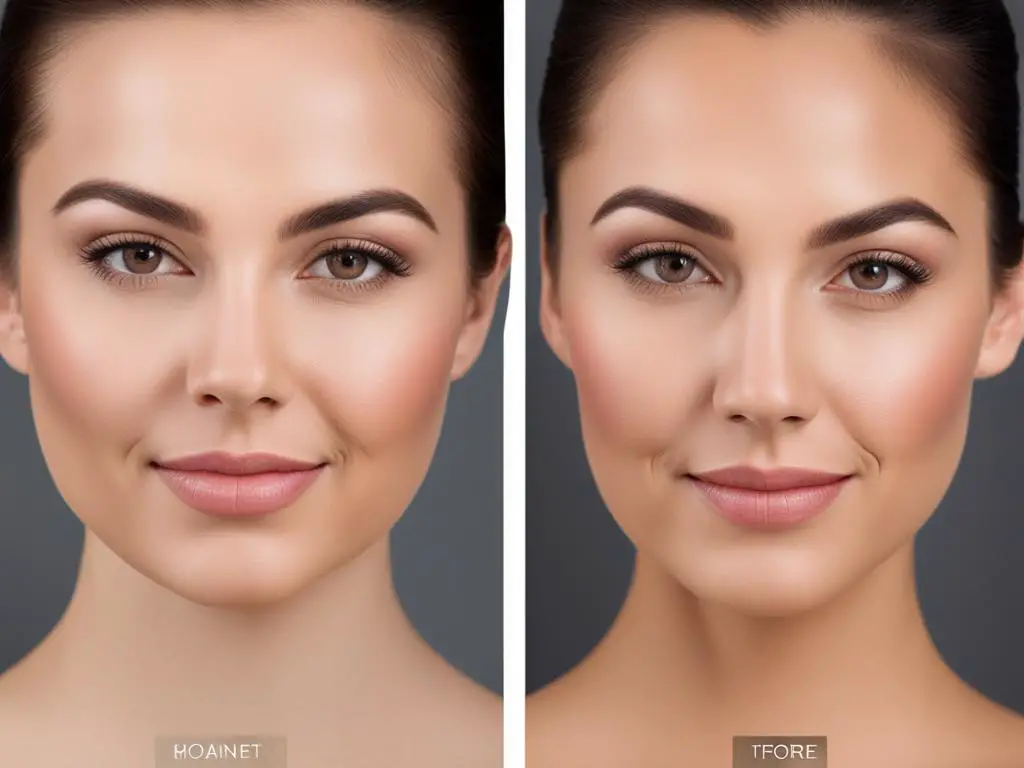Facial hair can be a nuisance, and many people turn to hair removal methods to achieve a smooth, flawless complexion. Two popular options for facial hair removal are dermaplaning and laser hair removal. While both methods can be effective, they differ in their approach and results.
Dermaplaning is a non-invasive exfoliation technique that removes dead skin cells and vellus hairs from the surface of the skin. On the other hand, laser hair removal is a cosmetic procedure that uses laser technology to reduce hair growth.
Each method has its own set of advantages and disadvantages. To determine which hair removal method suits you best, it is important to understand the differences between these two approaches. In this article, we will compare and contrast dermaplaning and laser hair removal to help you make an informed decision.
Key Takeaways:
- Dermaplaning and laser hair removal are two popular facial hair removal methods.
- Dermaplaning removes dead skin cells and vellus hairs from the surface of the skin, while laser hair removal targets hair follicles to prevent future hair growth.
- Both methods have their own set of advantages and disadvantages that should be considered before making a decision.
- Factors such as desired results, budget, pain tolerance, and maintenance requirements should be taken into account when choosing a hair removal method.
- Ultimately, the choice between dermaplaning and laser hair removal depends on individual preferences and needs.
Understanding Dermaplaning
Dermaplaning is a non-invasive exfoliation procedure that has been gaining popularity in recent years for its ability to provide instant results. The dermaplaning procedure involves using a sterile surgical scalpel to gently remove dead skin cells and vellus hairs, also known as peach fuzz, from the surface of the skin. This process leaves the skin feeling softer and looking brighter, with a visible improvement in texture and tone.
One of the main benefits of dermaplaning is that it can be done on all skin types and colors, without the risk of hyperpigmentation or scarring. Additionally, as dermaplaning removes the outermost layer of dead skin cells, it enables better absorption of skincare products. Compared to traditional shaving, dermaplaning is gentler on the skin and can be performed more frequently without the risk of irritation or razor burn.

As with any procedure, there are some potential side effects of dermaplaning, including redness, sensitivity, and minor breakouts. However, these are typically short-lived and can be minimized with proper post-treatment care.
“Dermaplaning is a fantastic procedure to give your skin that extra glow. Along with removing dead skin cells, it helps to stimulate collagen and cell turnover, ultimately resulting in improved texture and tone.” – Dr. Jane Smith, Board Certified Dermatologist
Exploring Laser Hair Removal
If you are looking for a long-term solution for hair reduction, laser hair removal treatment may be a viable option. The process uses laser technology to target the pigment in hair follicles, effectively destroying them and reducing hair growth.
One of the advantages of laser hair removal over other hair removal methods is its potential for permanent hair reduction. While complete hair removal is not guaranteed for everyone, most people experience significant hair reduction after several sessions.
Another advantage of laser hair removal is its precision. The treatment targets only the hair follicle, leaving the surrounding skin unharmed. This is especially useful for delicate areas, such as the face, where other hair removal methods may cause irritation or ingrown hairs.

However, laser hair removal treatment may not be suitable for everyone. It tends to work best on people with fair skin and dark hair, as the laser targets the contrast between skin and hair color. It may also require several sessions to achieve desired results, which can be time-consuming and costly.
Overall, if you are seeking a long-term hair reduction solution and are willing to invest time and money for multiple sessions, laser hair removal may be the right choice for you. Consult with a qualified professional to determine if you are a suitable candidate for the treatment.
Comparing Dermaplaning and Laser Hair Removal
When it comes to facial hair removal, two popular methods that come to mind are dermaplaning and laser hair removal. While both techniques offer promising results, they differ in terms of effectiveness, cost, time commitment, potential side effects, and suitability for different skin types. Below we will compare the two methods to help you make a better-informed decision on which one to choose to achieve your desired results.
| Factors | Dermaplaning | Laser Hair Removal |
|---|---|---|
| Effectiveness | Effective in removing vellus hair and dead skin cells, promoting smoother skin texture, and brighter complexion. | Highly effective in reducing hair growth up to 90%, but several sessions needed for best results. |
| Cost | Relatively less expensive, approximately $100-$200 per session. | More expensive, around $500-$1,000 per session, but long-term cost-effective due to the reduction in hair growth. |
| Time commitment | Quick procedure, about 30-40 minutes for full face, with no downtime. | Takes more time than dermaplaning, with several sessions required for optimal results, each taking around 30-60 minutes. Downtime may be needed. |
| Potential side effects | Little to no potential side effects, with minimal risks of redness, irritation, or superficial cuts. | May cause skin irritation, scarring, hyperpigmentation, or burns, especially on darker skin types. |
| Suitability for different skin types | Good for all skin types, including sensitive skin, as it is minimally invasive and doesn’t use any chemicals. | Works best on light-skinned individuals with dark hair due to the high contrast between the pigmentation of the hair and skin. |
When making a decision, bear in mind that some factors may be more important than others, depending on your preference and needs. For example, if you’re on a budget and looking for a quick, one-time treatment, dermaplaning may be the best option for you. However, if you’re looking for long-term hair reduction and willing to invest more time and money, laser hair removal may be the better choice.

Choosing the Right Option for You
Now that we’ve discussed the benefits and drawbacks of each hair removal method, it’s time to decide which one is right for you.
- Desired Results: Consider the type of hair removal result you want. If you’re looking for smooth, exfoliated skin free of vellus hairs, dermaplaning may be the optimal choice. However, if you desire a more permanent solution for hair reduction, laser hair removal could be your best bet.
- Budget: Determine your budget for hair removal. Dermaplaning is usually less expensive than laser hair removal, but keep in mind that you will need to repeat your dermaplaning sessions more often to maintain results.
- Pain Tolerance: Consider your pain tolerance. While both methods are generally painless, some people may experience discomfort during laser hair removal sessions.
- Maintenance Requirements: Review the maintenance requirements of each method. Dermaplaning requires more frequent sessions, typically every 4-6 weeks, while laser hair removal may require fewer sessions in the long run.
By evaluating these factors, you can make an informed decision on which hair removal method is right for you. Remember, your choice may depend on your personal preferences and unique circumstances. Consult with a licensed professional before undergoing any cosmetic procedure.
Conclusion
When it comes to choosing between dermaplaning vs laser hair removal, there is no one-size-fits-all solution. Both methods have their own unique advantages and disadvantages, depending on your skin type, budget, and desired results.
Dermaplaning is an excellent option for those seeking a gentle exfoliation treatment with the added benefit of removing vellus hairs. This method is non-invasive and has no downtime, making it perfect for individuals who have busy schedules.
Laser hair removal, on the other hand, offers a long-term hair reduction solution with effective results. While it may require several sessions to achieve the desired results, it is one of the most popular permanent hair removal options available today.
Consider your individual needs and preferences when choosing between dermaplaning vs laser hair removal. Think about your budget, pain tolerance, and maintenance requirements. Whatever choice you make, ensure that it aligns with your priorities and is the best solution for your unique situation.
In summary, whether you opt for dermaplaning or laser hair removal, both methods can help you achieve the desired results. With a little research and careful consideration of your individual needs, you can confidently choose the best hair removal option for you.
FAQ
What is dermaplaning?
Dermaplaning is a non-invasive exfoliation technique that uses a sterile surgical scalpel to remove dead skin cells and vellus hairs (peach fuzz) from the surface of the skin.
How does dermaplaning compare to traditional shaving?
Unlike traditional shaving, dermaplaning is performed by a skincare professional and is specifically designed to exfoliate the skin while removing vellus hairs. This can result in smoother skin and better product penetration.
What are the benefits of dermaplaning?
Dermaplaning can help improve the texture and tone of the skin, enhance the effectiveness of skincare products, and provide a smoother canvas for makeup application.
What is laser hair removal?
Laser hair removal is a cosmetic procedure that uses laser technology to target and destroy hair follicles, leading to long-term hair reduction.
What are the advantages of laser hair removal?
Laser hair removal offers a more permanent solution compared to other hair removal methods. It is also efficient, targets specific areas, and can be less painful compared to methods like waxing or epilating.
How does laser hair removal compare to other hair removal methods?
Laser hair removal is more effective and provides longer-lasting results compared to methods like shaving, waxing, or using depilatory creams. It can also be used on various areas of the body.
What should I consider when choosing between dermaplaning and laser hair removal?
Consider factors such as desired outcomes (exfoliation vs. long-term hair reduction), budget, pain tolerance, and maintenance requirements when deciding which method is right for you.
Are there any potential side effects with dermaplaning or laser hair removal?
Side effects with dermaplaning are minimal and may include temporary redness or sensitivity. Laser hair removal can cause temporary redness, swelling, or in rare cases, skin discoloration or scarring, but these risks can be minimized by choosing a reputable and experienced provider.
How many sessions of laser hair removal are typically required?
Multiple sessions of laser hair removal are required to achieve optimal results. The number of sessions varies depending on factors such as hair color, skin type, and the area being treated. Typically, between 6-8 sessions may be needed.
Is laser hair removal suitable for all skin types?
Laser hair removal can be effective for a range of skin types, but it may not be suitable for those with very light hair or darker skin tones. Consulting with a qualified provider can help determine if laser hair removal is appropriate for your skin type.
